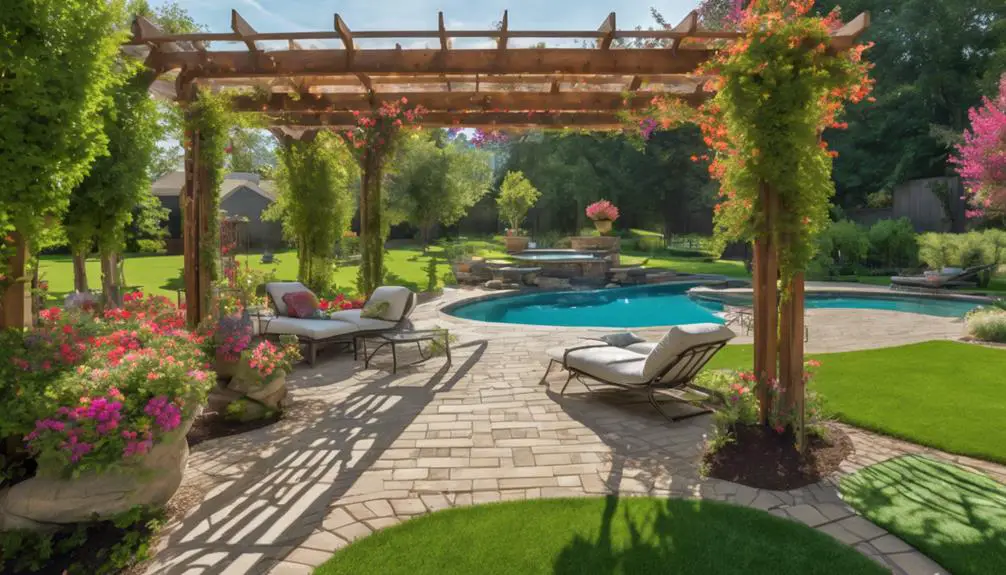As you step into your backyard, you envision a space where your family can create lasting memories. You imagine a haven that seamlessly blends functionality and style, catering to everyone's unique needs. From kids' playtime to family gatherings, a well-designed layout is key. But where do you start? You've got a blank slate, and the possibilities are endless. You'll need to ponder the layout's various zones, from play areas to seating spaces, and think about how to incorporate essential elements like outdoor kitchens, water features, and lighting. The question is, what's the perfect blend for your family's lifestyle?
Assessing Your Yard's Potential
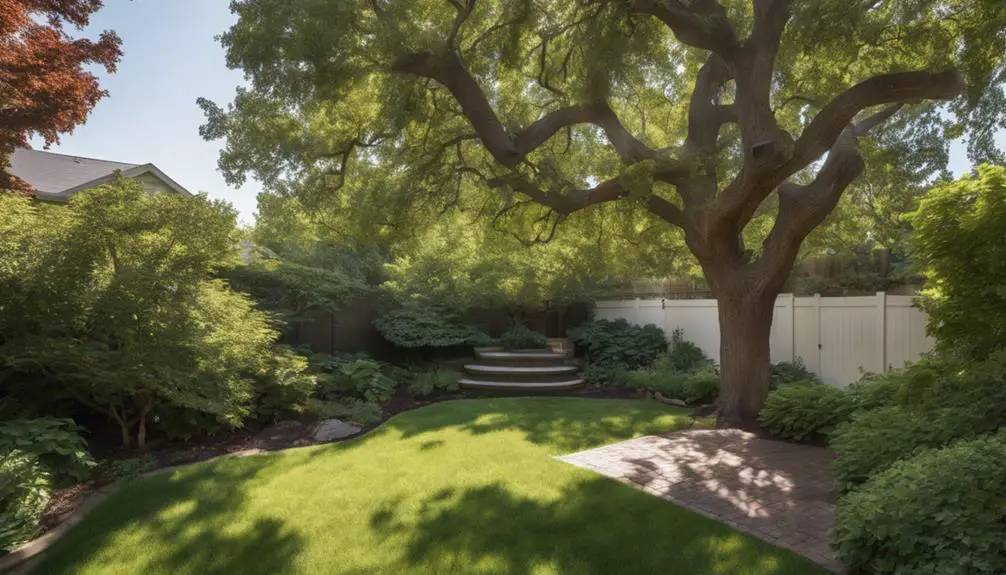
As you step into your yard, take a moment to observe its layout, noting the areas that receive direct sunlight, partial shade, or full shade.
This initial assessment is vital in understanding your yard's potential. Create a mental or physical map of your yard, identifying areas with varying levels of sunlight and shade.
This yard mapping exercise will help you visualize your outdoor space and identify opportunities for optimization.
Conduct a site analysis to gather more detailed information about your yard's topography, soil type, and drainage patterns.
Measure the dimensions of your yard, including the location and size of any existing features such as trees, gardens, and hardscapes.
Take note of any slopes, uneven terrain, or areas prone to waterlogging.
By gathering this data, you'll be able to identify potential challenges and opportunities for innovation in your backyard design.
This information will serve as the foundation for creating a functional and aesthetically pleasing outdoor space that meets your needs and exceeds your expectations.
Defining Different Zones
With your yard's layout and site analysis complete, you're now ready to define different zones within your outdoor space.
This vital step involves zone mapping, where you identify specific areas that serve distinct purposes. By doing so, you'll create a functional and organized yard that caters to your family's diverse needs.
Start by setting boundaries for each zone.
Consider the activities you want to accommodate, such as dining, relaxation, play, or entertainment. Visualize the flow of traffic and how each zone will interact with others. For instance, you might create a separate zone for children's play equipment, another for outdoor seating, and a third for gardening or cooking.
As you set boundaries, confirm they're clear and well-defined.
Use physical dividers like hedges, screens, or paths to separate zones, or employ visual cues like different flooring materials or plant species. By establishing distinct zones, you'll create a harmonious and efficient outdoor space that's both functional and aesthetically pleasing.
Playing It Safe for Kids
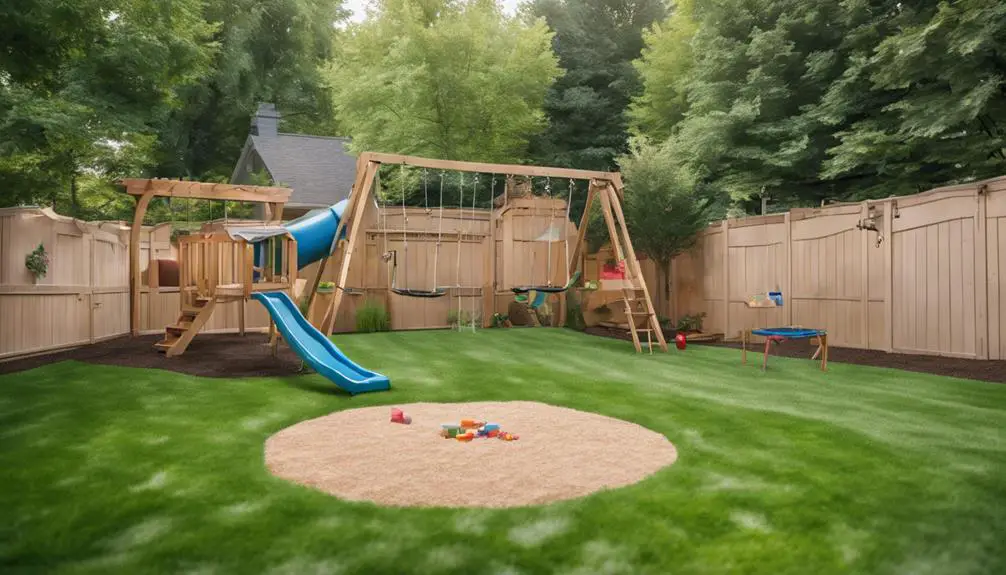
A sandbox or play structure marks the boundary of your kid's zone, a haven where imagination knows no bounds.
As you design this space, safety should be top of mind. You'll want to incorporate kid-friendly surfaces that can withstand rough play and minimize the risk of injury.
Consider installing rubber mulch or poured-in-place rubber beneath play equipment to create soft landing zones. These materials provide a cushioned surface that can help reduce the impact of falls.
Additionally, you can incorporate shock-absorbing materials like wood chips or artificial turf to create a safe and comfortable play area.
When selecting play equipment, opt for structures with rounded edges and smooth surfaces to prevent cuts and bruises. Make sure to leave enough space between equipment to prevent collisions and allow kids to move freely.
Creating a Cozy Seating Area
Six to eight feet of clearance around a seating area is essential to create an intimate, cozy atmosphere.
This allows you to define the space without making it feel cramped. Consider the Seating Styles you want to incorporate – will it be a circular arrangement for conversation or a linear setup for relaxation?
Next, think about the Cozy Textiles that will bring warmth to the space.
Choose plush throw pillows, blankets, and upholstery in natural hues that evoke a sense of serenity. You can also add warmth with outdoor heaters or a fire pit, which will extend the use of the seating area into the cooler months.
To create visual interest, add varying textures and heights to the space.
Incorporate plants with different foliage and bloom times to guarantee year-round interest. Consider adding a statement piece, like a sculpture or a water-resistant console table, to anchor the space.
Incorporating Water Features

Water features, such as fountains or ponds, introduce a dynamic visual and auditory element to your backyard layout, generating a sense of tranquility and calmness.
By incorporating water features, you'll create a multisensory experience that invites relaxation and contemplation. Consider adding a small pond with a gentle waterfall, which won't only create a soothing sound but also attract local wildlife.
For a more dramatic effect, you can opt for a larger pond with a cascading waterfall, creating a striking visual focal point in your backyard.
When designing your water feature, consider the style and theme of your backyard.
For a modern look, a sleek, linear fountain or a minimalist pond with a subtle waterfall might be the way to go. For a more rustic or natural look, a meandering stream or a pond with a natural rock surround could be a better fit.
Whatever style you choose, make sure to balance your water feature with surrounding plants and hardscapes to create a harmonious and visually appealing space.
Adding a Fire Pit or Outdoor Fireplace
When you add a fire pit or outdoor fireplace to your backyard, you'll need to ponder safety features, such as a heat-resistant surface and a fire screen, to guarantee a safe and enjoyable gathering space.
You'll also want to reflect on the overall design, including the size and shape of the pit or fireplace, as well as the surrounding seating area, to create a cozy and inviting atmosphere.
Fire Pit Safety
How close should you place flammable objects to your fire pit or outdoor fireplace? The answer is simple: not close at all.
Keep anything that can catch fire, such as leaves, branches, or outdoor furniture, at least 10 feet away from the fire pit or outdoor fireplace. This is vital to minimize fire pit risks and guarantee emergency preparedness.
When designing your backyard layout, consider the direction of the wind and the proximity of flammable structures, like your house or nearby trees.
You should also maintain a clear escape route in case of an emergency. Keep a fire extinguisher or a bucket of sand nearby, and make sure it's easily accessible.
Gathering Space Design
Three key zones comprise a well-designed gathering space around a fire pit or outdoor fireplace: a seating area, a conversation circle, and a peripheral zone.
You'll want to allocate sufficient space for each zone to guarantee a comfortable and functional layout. The seating area should provide ample room for your family and guests to sit, relax, and enjoy the warmth of the fire.
Consider incorporating built-in benches, outdoor sofas, or Adirondack chairs to create a cozy atmosphere.
The conversation circle is where the magic happens, facilitating casual entertaining and family gatherings.
Position seating in a circular pattern to encourage interaction and conversation. You can also add a few accent chairs or ottomans to create a more intimate setting.
The peripheral zone serves as a buffer between the gathering space and the rest of the backyard.
This area can be used for additional seating, outdoor heaters, or even a bar or food station.
Building an Outdoor Kitchen

Functionality and style converge in the outdoor kitchen, where the boundaries between cooking, dining, and socializing blur.
You'll want to thoughtfully select kitchen appliances that can withstand the elements while still delivering exceptional performance. Consider built-in grills, smokers, or pizza ovens that double as statement pieces.
Outdoor refrigerators and ice makers will keep your drinks and ingredients chilled, while an outdoor dishwasher saves you the hassle of hauling dirty dishes back inside.
To create a cohesive look, integrate outdoor decor elements, such as pendant lights, decorative tile, and natural stone countertops.
Incorporate clever storage solutions, like pull-out trash cans and utensil holders, to maintain a clutter-free space.
Don't forget to plan for ample counter space, seating, and shade – essential components of a functional outdoor kitchen.
Landscaping for Function and Beauty
As you step away from the outdoor kitchen, your attention turns to the surrounding landscape, where the beauty of nature meets the functionality of clever design.
You envision a seamless blend of aesthetics and purpose, where every element serves a dual role. To achieve this landscape harmony, you'll need to weigh the yard's topography, soil type, and sunlight patterns.
You'll also want to incorporate native plants and trees that not only thrive in your local climate but also provide shade, texture, and color.
In your yard visualization, imagine a series of interconnected spaces that flow effortlessly from one to another.
Define these zones using pathways, hardscapes, and strategically placed plantings. Ponder adding a statement piece, like a water feature or sculpture, to draw the eye and create visual interest.
Incorporating Outdoor Lighting
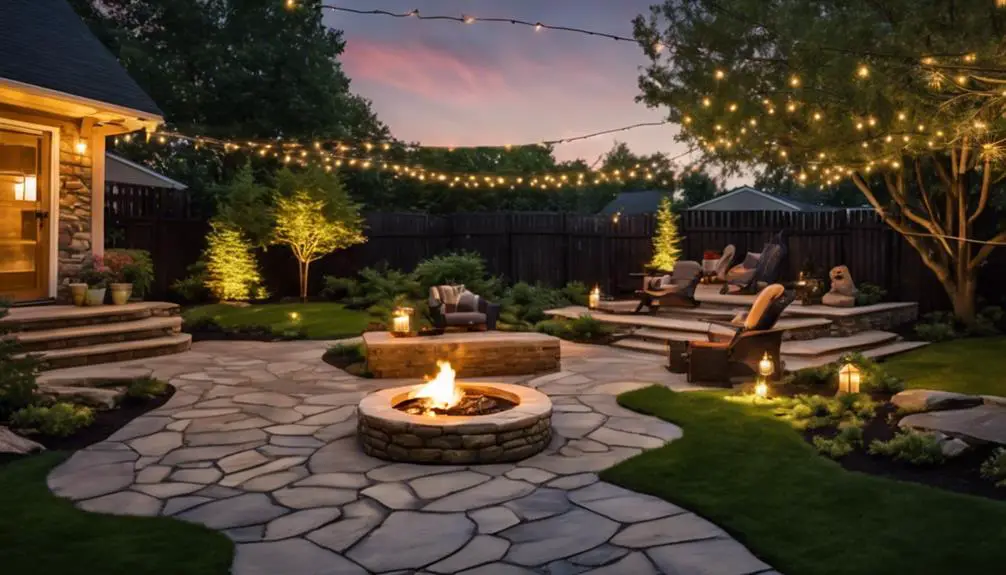
When daylight fades, your backyard's ambiance transforms, and the strategic placement of outdoor lighting becomes essential to extending your outdoor living experience.
As you plan your backyard layout, consider the role lighting plays in creating a welcoming atmosphere and enhancing safety. Solar lanterns, for instance, can add a warm glow to seating areas, while pathway illumination helps guide guests through your outdoor space.
To create a cohesive look, choose fixtures that complement your home's architectural style and blend with the surrounding landscape. Consider layering different light sources, such as ambient, task, and accent lighting, to create visual interest and highlight specific features.
Utilizing Vertical Space
Your backyard's walls, fences, and trellises offer a wealth of untapped potential for adding depth, texture, and visual appeal to your outdoor space.
By utilizing vertical space, you can create a multi-dimensional landscape that maximizes every inch of your yard. Consider installing a living wall or vertical garden, which can be attached to a fence, wall, or even a freestanding trellis.
These innovative features not only add aesthetic value but also provide a habitat for plants, improving air quality and creating a natural ambiance.
To take your vertical garden to the next level, incorporate a trellis system that supports climbing plants, such as ivy or clematis.
This will add a dynamic, layered effect to your outdoor space. Alternatively, you can use wall-mounted planters or shelves to display potted plants, herbs, or succulents.
Making Room for Outdoor Storage
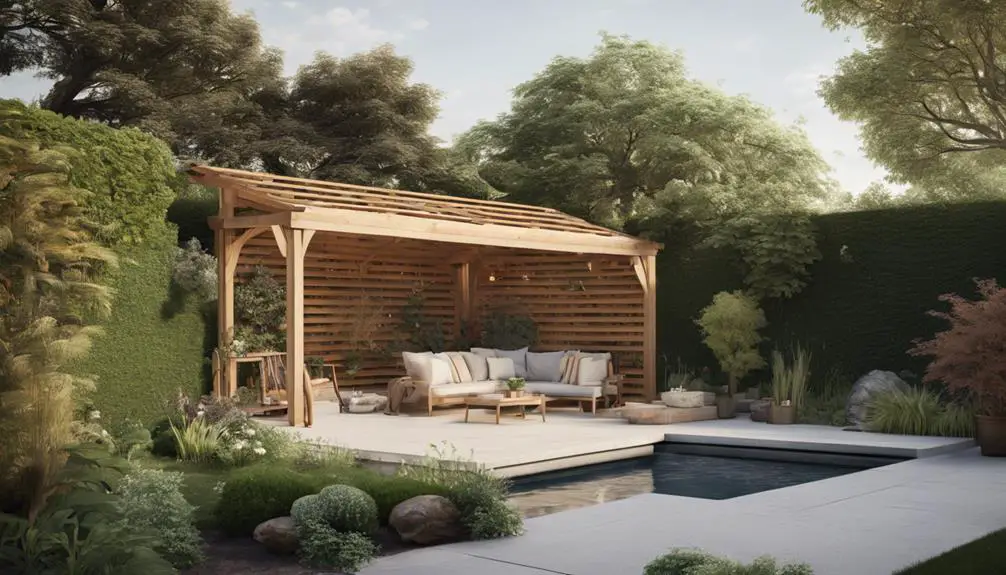
Optimizing your backyard's layout involves allocating space for outdoor storage, a crucial aspect of maintaining a clutter-free and functional outdoor area.
By incorporating strategic storage solutions, you can keep your yard organized and free from clutter, creating a more inviting space for relaxation and entertainment.
When it comes to outdoor storage, a well-organized shed is essential.
Consider implementing shed organization systems, such as shelving, hooks, and bins, to maximize storage capacity and keep frequently used items within easy reach.
This will help you quickly find what you need, saving you time and frustration.
Additionally, consider incorporating storage into your fence decor.
Built-in planters, decorative screens, or trellises can provide additional storage for outdoor accessories, such as gardening tools, pool equipment, or outdoor furniture cushions.
By integrating storage into your fence design, you can maintain a clean and clutter-free appearance while still keeping essential items within reach.
Balancing Style and Functionality
Beyond allocating space for outdoor storage, a well-designed backyard layout must strike a balance between style and functionality.
You'll want to create a harmonious blend of aesthetics and practicality to guarantee your outdoor space is both beautiful and functional. To achieve this balance, consider incorporating curved pathways that guide visitors through your yard, creating a sense of fluidity and visual appeal.
These pathways can also help define different areas of your yard, such as a seating area or a play zone.
Focal points are another vital element in balancing style and functionality.
By creating focal points, such as a statement piece of art or a stunning water feature, you can draw the eye to specific areas of your yard, creating visual interest and depth.
This will also help distract from any functional elements, like outdoor storage, that may not be the most visually appealing.
Frequently Asked Questions
How Do I Handle Uneven Terrain in My Backyard Design?
When tackling uneven terrain, you'll need to weigh grading options to balance elevation changes. You'll assess the site's slope, identifying areas that require cutting or filling to create a functional, visually appealing space that flows seamlessly.
Can I Install a Backyard Feature With a Small Budget?
You can still create a stunning outdoor space despite budget constraints by prioritizing small splurges, like a statement piece or focal point, and balancing them with cost-effective materials and DIY elements to achieve a high-end look on a budget.
What Are Some Eco-Friendly Materials for Outdoor Construction?
You'll find innovative, eco-friendly materials for outdoor construction in sustainable lumber, recycled plastic, and eco-friendly concrete, which pair perfectly with low-maintenance plants and green roofing, allowing you to build a stunning, environmentally responsible space that's both functional and visually striking.
How Do I Prevent Pests From Ruining My Outdoor Space?
You'll want to employ multifaceted pest control methods, incorporating natural deterrents like citronella, lemongrass, and mint to repel unwanted critters, while sealing entry points and maintaining a clean space to prevent infestations, ensuring a pest-free outdoor oasis.
Can I DIY a Backyard Project or Do I Need a Professional?
You decide whether to DIY a backyard project or hire a pro, considering design constraints and your personal style; weigh your skills, time, and budget to determine if you can bring your unique vision to life.
Conclusion
You've carefully crafted your family backyard layout, balancing style and functionality. Now, envision the space coming to life: kids laughing in the play area, family gatherings in the cozy seating zone, and sizzling meals from the outdoor kitchen. As night falls, water features glisten, fire pits crackle, and strategic lighting highlights the space's best features. Your thoughtful design has created a harmonious blend of form and function, where every family member can thrive.
